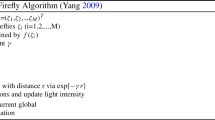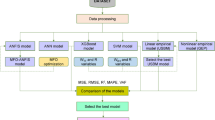Abstract
This article develops an optimal design method with multiple stages for a flexure mechanism. This mechanism can be employed as a rotary joint or a torsional spring. The developed method is a hybridization of density-based topology, multilayer perceptron, and water cycle-moth flame algorithm. Firstly, the topology design for flexure mechanism is conducted to create a draft shape of flexure mechanism, and it is redesigned to seek a proper structure. Secondly, datasets of finite element simulations are collected. These data are then normalized, and the feed-forward multilayer perceptron (FMLP) is utilized to formulate the regression models for all performances. In order to determine the best suitable parameters of each FMLP model, their architectures are optimized by the Taguchi technique. By evaluating the measurement indexes such as correlation coefficient, mean square error, and root mean square error, the developed FMLP models show a superiority as compared to the multiple linear regression. Then, the sensitivity of design parameters is investigated. Thirdly, based on the well-established FMLP models, the size optimization is conducted by the water cycle-moth flame algorithm. Finally, in comparison with the FMLP-based differential evolution, FMLP-based firefly algorithm, FMLP-based particle swarm optimization, and FMLP-based teaching-learning based optimization, the present method has a better efficiency through the Friedman and Wilcoxon tests.










Similar content being viewed by others
References
Howell LL, Magleby SP, Olsen BM (2013) Handbook of compliant mechanisms. John Wiley & Sons
Ding B, Yang ZX, Xiao X, Zhang G (2019) Design of reconfigurable planar micro-positioning stages based on function modules. IEEE Access 7:15102–15112. https://doi.org/10.1109/ACCESS.2019.2894619
Ling M, Cao J, Jiang Z, Lin J (2017) Modular kinematics and statics modeling for precision positioning stage. Mech Mach Theory. https://doi.org/10.1016/j.mechmachtheory.2016.10.009
Xi X, Clancy T, Wu X et al (2016) A MEMS XY-stage integrating compliant mechanism for nanopositioning at sub-nanometer resolution. J Micromech Microeng 26:25014. https://doi.org/10.1088/0960-1317/26/2/025014
Qin F, Gong D, Chen Y et al (2019) Integrated piezoelectric micromechanical vibration platform for six degree of freedom motion. J Micromech Microeng. https://doi.org/10.1088/1361-6439/ab3b17
Chandrasekaran K, Thondiyath A (2017) Design of a two degree-of-freedom compliant tool tip for a handheld powered surgical tool. J Med Devices Trans ASME. https://doi.org/10.1115/1.4034879
George BL, Bharanidaran R (2020) Design of multifunctional compliant forceps for medical application. Aust J Mech Eng. https://doi.org/10.1080/14484846.2020.1747151
Ho NL, Dao TP, Le Chau N, Huang SC (2019) Multi-objective optimization design of a compliant microgripper based on hybrid teaching learning-based optimization algorithm. Microsyst Technol. https://doi.org/10.1007/s00542-018-4222-6
Qiang L, Longjia Z, He B et al (2021) Design and analysis of three-dimensional compliant structure suitable for integrated design of support and drive of space optical mirror. Optik (Stuttg). https://doi.org/10.1016/j.ijleo.2020.165757
Zhao D, Zhu Z, Huang P et al (2020) Development of a piezoelectrically actuated dual-stage fast tool servo. Mech Syst Signal Process. https://doi.org/10.1016/j.ymssp.2020.106873
Chen W, Zhang X, Li H et al (2017) Nonlinear analysis and optimal design of a novel piezoelectric-driven compliant microgripper. Mech Mach Theory 118:32–52. https://doi.org/10.1016/j.mechmachtheory.2017.07.011
Yang ZW, Lan CC (2015) An adjustable gravity-balancing mechanism using planar extension and compression springs. Mech Mach Theory 92:314–329. https://doi.org/10.1016/j.mechmachtheory.2015.05.006
Hsieh HC, Chen DF, Chien L, Lan CC (2017) Design of a parallel actuated exoskeleton for adaptive and safe robotic shoulder rehabilitation. IEEE/ASME Trans Mechatron. https://doi.org/10.1109/TMECH.2017.2717874
Xu Q (2015) Design of a large-range compliant rotary micropositioning stage with angle and torque sensing. IEEE Sens J. https://doi.org/10.1109/JSEN.2014.2377779
Wang P, Yang S, Xu Q (2018) Design and optimization of a new compliant rotary positioning stage with constant output torque. Int J Precis Eng Manuf. https://doi.org/10.1007/s12541-018-0213-x
Xu Q (2013) Design and implementation of a novel rotary micropositioning system driven by linear voice coil motor. Rev Sci Instrum. https://doi.org/10.1063/1.4803187
Nguyen DN, Dao T, Chau N Le, Dang VA (2019) Hybrid approach of finite element method, Kigring metamodel, and multiobjective genetic algorithm for computational optimization of a flexure elbow joint for upper-limb assistive device. https://www.springer.com/engineering/electronics/j. Accessed 20 April 2021
Chau N Le, Le HG, Dao T, et al (2019) Efficient hybrid method of FEA-based RSM and PSO algorithm for multi-objective optimization design for a compliant rotary joint for upper limb assistive device. https://www.springer.com/engineering/electronics/j. Accessed 20 April 2021
Lobontiu N (2002) Compliant mechanisms: design of flexure hinges. CRC press, Routledge
Tran NT, Le Chau N, Dao TP (2020) A new butterfly-inspired compliant joint with 3-DOF in-plane motion. Arab J Sci Eng. https://doi.org/10.1007/s13369-020-04415-8
Le CN, Dao TP, Nguyen VTT (2018) Optimal design of a dragonfly-inspired compliant joint for camera positioning system of nanoindentation tester based on a hybrid integration of jaya-ANFIS. Math Probl Eng. https://doi.org/10.1155/2018/8546095
Al-Jodah A, Shirinzadeh B, Ghafarian M et al (2020) A fuzzy disturbance observer based control approach for a novel 1-DOF micropositioning mechanism. Mechatronics. 65(102317):1–15https://doi.org/10.1016/j.mechatronics.2019.102317
Wang F, Zhao X, Huo Z et al (2021) A 2-DOF nano-positioning scanner with novel compound decoupling-guiding mechanism. Mech Mach Theory 155(104066):1–14
Ding B, Li Y, Xiao X et al (2017) Design and analysis of a 3-DOF planar micromanipulation stage with large rotational displacement for micromanipulation system. Mech Sci. https://doi.org/10.5194/ms-8-117-2017
Pinskier J, Shirinzadeh B, Clark L, Qin Y (2018) Development of a 4-DOF haptic micromanipulator utilizing a hybrid parallel-serial flexure mechanism. Mechatronics. https://doi.org/10.1016/j.mechatronics.2018.01.007
Chen W, Yang S, Liu J et al (2017) Design of a novel 5-DOF flexure-based compound alignment stage for roll-to-roll printed electronics. Rev Sci Instrum. https://doi.org/10.1063/1.4974814
Zhang D, Li P, Zhang J et al (2019) Design and assessment of a 6-DOF micro/nanopositioning system. IEEE/ASME Trans Mechatron 24:2097–2107. https://doi.org/10.1109/TMECH.2019.2931619
Edwards BT, Jensen BD, Howell LL (2001) A pseudo-rigid-body model for initially-curved pinned-pinned segments used in compliant mechanisms. J Mech Des Trans ASME. https://doi.org/10.1115/1.1376396
Ling M, Cao J, Pehrson N (2019) Kinetostatic and dynamic analyses of planar compliant mechanisms via a two-port dynamic stiffness model. Precis Eng 57:149–161. https://doi.org/10.1016/j.precisioneng.2019.04.004
Choi SB, Han SS, Han YM, Thompson BS (2007) A magnification device for precision mechanisms featuring piezoactuators and flexure hinges: design and experimental validation. Mech Mach Theory. https://doi.org/10.1016/j.mechmachtheory.2006.08.009
Le ZhuW, Zhu Z, Shi Y et al (2016) Design, modeling, analysis and testing of a novel piezo-actuated XY compliant mechanism for large workspace nano-positioning. Smart Mater Struct 25:1–17. https://doi.org/10.1088/0964-1726/25/11/115033
Ling M, Howell LL, Cao J, Chen G (2020) Kinetostatic and dynamic modeling of flexure-based compliant mechanisms: a survey. Appl Mech Rev 72. https://doi.org/10.1115/1.4045679
Sigmund O, Maute K (2013) Topology optimization approaches: a comparative review. Struct Multidiscip Optim 48:1031–1055
Qiu L, Yue X, Xie Z (2019) Design and analysis of Multicavity Flexure Hinge (MCFH) based on three-dimensional continuum topology optimization. Mech Mach Theory 139:21–33. https://doi.org/10.1016/j.mechmachtheory.2019.04.004
Cao L, Dolovich AT, Zhang WC (2015) Hybrid compliant mechanism design using a mixed mesh of flexure hinge elements and beam elements through topology optimization. J Mech Des Trans ASME. https://doi.org/10.1115/1.4030990
De Leon DM, Alexandersen J, Jun JS, Sigmund O (2015) Stress-constrained topology optimization for compliant mechanism design. Struct Multidiscip Optim. https://doi.org/10.1007/s00158-015-1279-z
Xia Q, Shi T (2016) Topology optimization of compliant mechanism and its support through a level set method. Comput Methods Appl Mech Eng. https://doi.org/10.1016/j.cma.2016.03.017
Kuresangsai P, Cole MOT (2019) Kinematic modeling and design optimization of flexure-jointed planar mechanisms using polynomial bases for flexure curvature. Mech Mach Theory. https://doi.org/10.1016/j.mechmachtheory.2018.10.006
Wang N, Zhang Z, Zhang X, Cui C (2018) Optimization of a 2-DOF micro-positioning stage using corrugated flexure units. Mech Mach Theory 121:683–696. https://doi.org/10.1016/j.mechmachtheory.2017.11.021
Lu Q, Cui Z, Chen X (2015) Fuzzy multi-objective optimization for movement performance of deep-notch elliptical flexure hinges. Rev Sci Instrum. https://doi.org/10.1063/1.4922914
Talaat M, Farahat MA, Mansour N, Hatata AY (2020) Load forecasting based on grasshopper optimization and a multilayer feed-forward neural network using regressive approach. Energy. https://doi.org/10.1016/j.energy.2020.117087
Guo H, Zhou J, Koopialipoor M et al (2019) Deep neural network and whale optimization algorithm to assess flyrock induced by blasting. Eng Comput. https://doi.org/10.1007/s00366-019-00816-y
Zhou J, Nekouie A, Arslan CA et al (2019) Novel approach for forecasting the blast-induced AOp using a hybrid fuzzy system and firefly algorithm. Eng Comput. https://doi.org/10.1007/s00366-019-00725-0
Mishra M, Bhatia AS, Maity D (2019) A comparative study of regression, neural network and neuro-fuzzy inference system for determining the compressive strength of brick–mortar masonry by fusing nondestructive testing data. Eng Comput. https://doi.org/10.1007/s00366-019-00810-4
Sack S, Åbom M (2020) Acoustic plane-wave decomposition by means of multilayer perceptron neural networks. J Sound Vib. https://doi.org/10.1016/j.jsv.2020.115518
Li R, Liu Z, Rohskopf A et al (2020) A deep neural network interatomic potential for studying thermal conductivity of β-Ga2O3. Appl Phys Lett. https://doi.org/10.1063/5.0025051
Eskandari-Naddaf H, Kazemi R (2017) ANN prediction of cement mortar compressive strength, influence of cement strength class. Constr Build Mater. https://doi.org/10.1016/j.conbuildmat.2017.01.132
Zhou Y, Wang Y, Wang K et al (2020) Hybrid genetic algorithm method for efficient and robust evaluation of remaining useful life of supercapacitors. Appl Energy. https://doi.org/10.1016/j.apenergy.2019.114169
Liu H, Cai Z, Wang Y (2010) Hybridizing particle swarm optimization with differential evolution for constrained numerical and engineering optimization. Appl Soft Comput J. https://doi.org/10.1016/j.asoc.2009.08.031
Awad NH, Ali MZ, Mallipeddi R, Suganthan PN (2019) An efficient differential evolution algorithm for stochastic OPF based active–reactive power dispatch problem considering renewable generators. Appl Soft Comput J. https://doi.org/10.1016/j.asoc.2018.12.025
Ding X, Hasanipanah M, Nikafshan Rad H, Zhou W (2020) Predicting the blast-induced vibration velocity using a bagged support vector regression optimized with firefly algorithm. Eng Comput. https://doi.org/10.1007/s00366-020-00937-9
Rao RV, Savsani VJ, Vakharia DP (2011) Teaching-learning-based optimization: a novel method for constrained mechanical design optimization problems. Comput Aided Des 43:303–315. https://doi.org/10.1016/j.cad.2010.12.015
Venkata Rao R (2016) Jaya: a simple and new optimization algorithm for solving constrained and unconstrained optimization problems. Int J Ind Eng Comput. https://doi.org/10.5267/j.ijiec.2015.8.004
Tran NT, Le Chau N, Dao TP (2020) An effective hybrid approach of desirability, fuzzy logic, ANFIS and LAPO algorithm for optimizing compliant mechanism. Eng Comput. https://doi.org/10.1007/s00366-020-00963-7
Rao RV, Pawar RB (2020) Constrained design optimization of selected mechanical system components using Rao algorithms. Appl Soft Comput J. https://doi.org/10.1016/j.asoc.2020.106141
Eskandar H, Sadollah A, Bahreininejad A, Hamdi M (2012) Water cycle algorithm—a novel metaheuristic optimization method for solving constrained engineering optimization problems. Comput Struct. https://doi.org/10.1016/j.compstruc.2012.07.010
Mirjalili S (2015) Moth-flame optimization algorithm: a novel nature-inspired heuristic paradigm. Knowl Based Syst. https://doi.org/10.1016/j.knosys.2015.07.006
Ashour AS (2020) Springer tracts in nature-inspired computing. Applied nature—inspired computing: algorithms and case studies. Springer, Singapore
Nilanjan D (2017) Advancements in applied metaheuristic computing. IGI Global
Dey N, Chaki J, Moraru L et al (2020) Firefly algorithm and its variants in digital image processing: a comprehensive review. Springer, Singapore
Sarkar M, Banerjee S, Badr Y, Sangaiah AK (2017) Configuring a trusted cloud service model for smart city exploration using hybrid intelligence. Int J Ambient Comput Intell 8:1–21. https://doi.org/10.4018/IJACI.2017070101
Chatterjee S, Sarkar S, Hore S et al (2017) Particle swarm optimization trained neural network for structural failure prediction of multistoried RC buildings. Neural Comput Appl 28:2005–2016. https://doi.org/10.1007/s00521-016-2190-2
Khadse VM, Mahalle PN, Shinde GR (2020) Statistical study of machine learning algorithms using parametric and non-parametric tests. Int J Ambient Comput Intell 11:80–105. https://doi.org/10.4018/ijaci.2020070105
Khalilpourazari S, Khalilpourazary S (2019) An efficient hybrid algorithm based on water cycle and moth-flame optimization algorithms for solving numerical and constrained engineering optimization problems. Soft Comput. https://doi.org/10.1007/s00500-017-2894-y
Acknowledgements
This research is supported by Industrial University of Ho Chi Minh City (IUH) under grant number 118/HD-DHCN.
Author information
Authors and Affiliations
Corresponding author
Ethics declarations
Conflict of interest
The authors declare that they have no conflict of interest.
Additional information
Publisher's Note
Springer Nature remains neutral with regard to jurisdictional claims in published maps and institutional affiliations.
Rights and permissions
About this article
Cite this article
Chau, N.L., Tran, N.T. & Dao, TP. A hybrid approach of density-based topology, multilayer perceptron, and water cycle-moth flame algorithm for multi-stage optimal design of a flexure mechanism. Engineering with Computers 38 (Suppl 4), 2833–2865 (2022). https://doi.org/10.1007/s00366-021-01417-4
Received:
Accepted:
Published:
Issue Date:
DOI: https://doi.org/10.1007/s00366-021-01417-4




